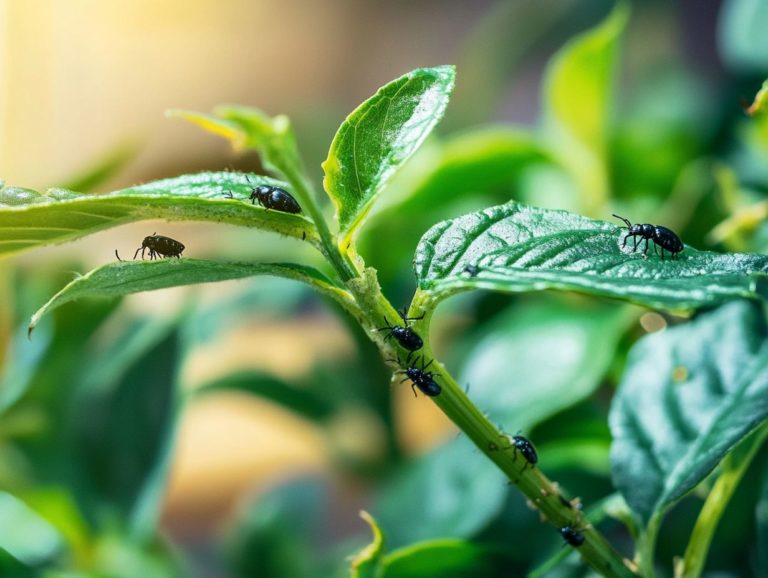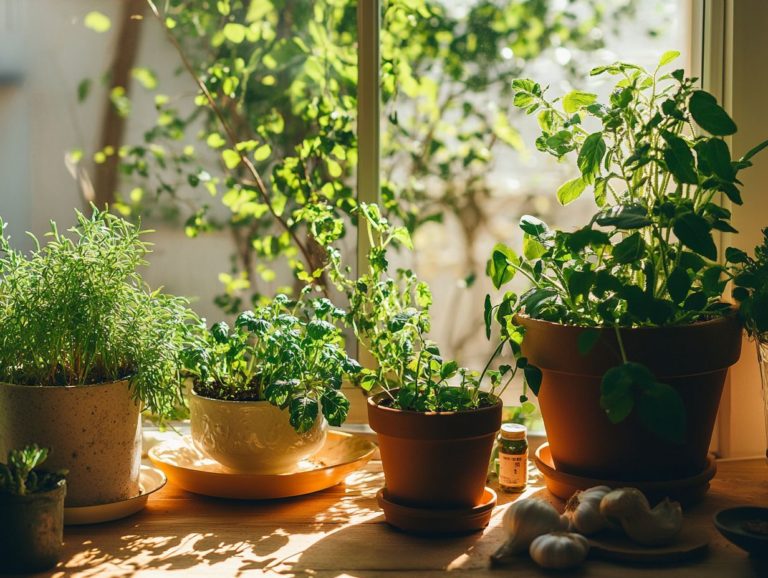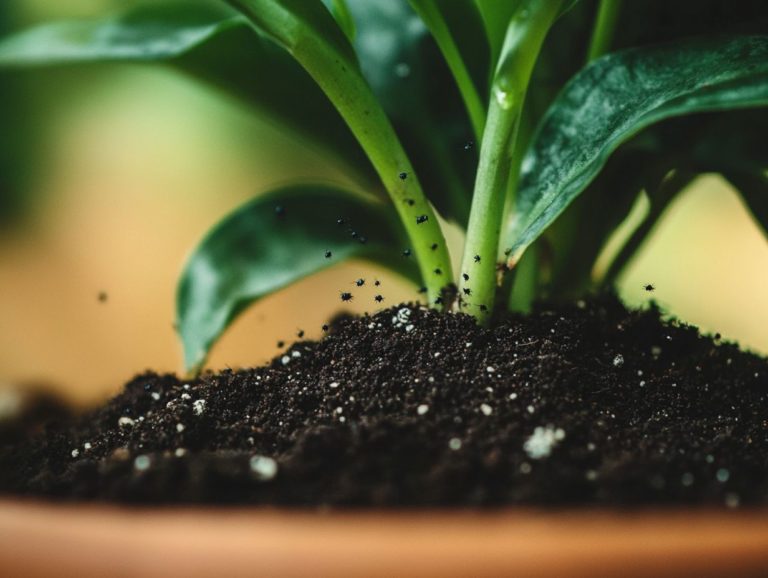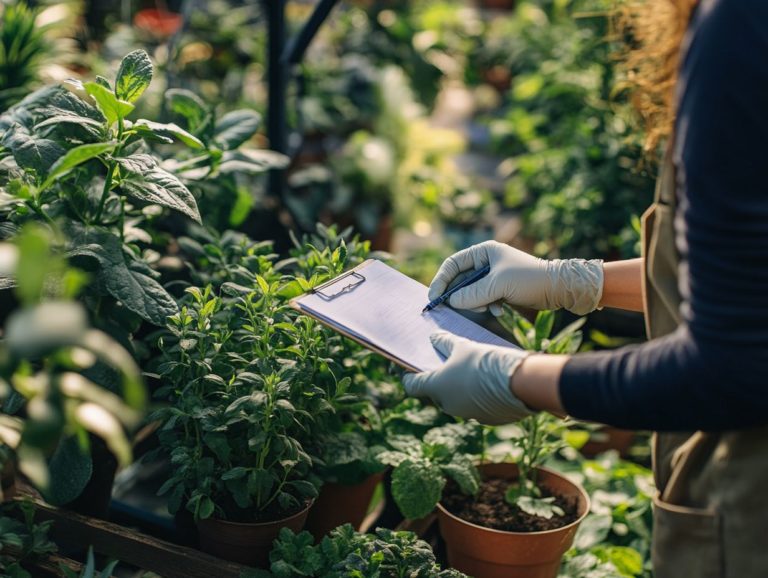How to Safely Use Insecticidal Soap
In your journey toward cultivating a flourishing garden, pest control quickly becomes a vital subject for any dedicated plant enthusiast.
Homemade insecticidal soap can be created using simple ingredients, making it an accessible choice for those interested in organic gardening. Utilizing insecticidal soap aligns well with the principles of organic gardening, as it helps maintain a balanced ecosystem in your garden. It stands out as a premier option for those in search of an effective yet environmentally friendly solution.
This article also explores what insecticidal soap is, its myriad benefits, and the best practices for using it safely and effectively.
It sheds light on common missteps to avoid and explores alternative pest control methods, ensuring you are thoroughly equipped to safeguard your plants without compromising the health of the environment.
Contents
Key Takeaways:
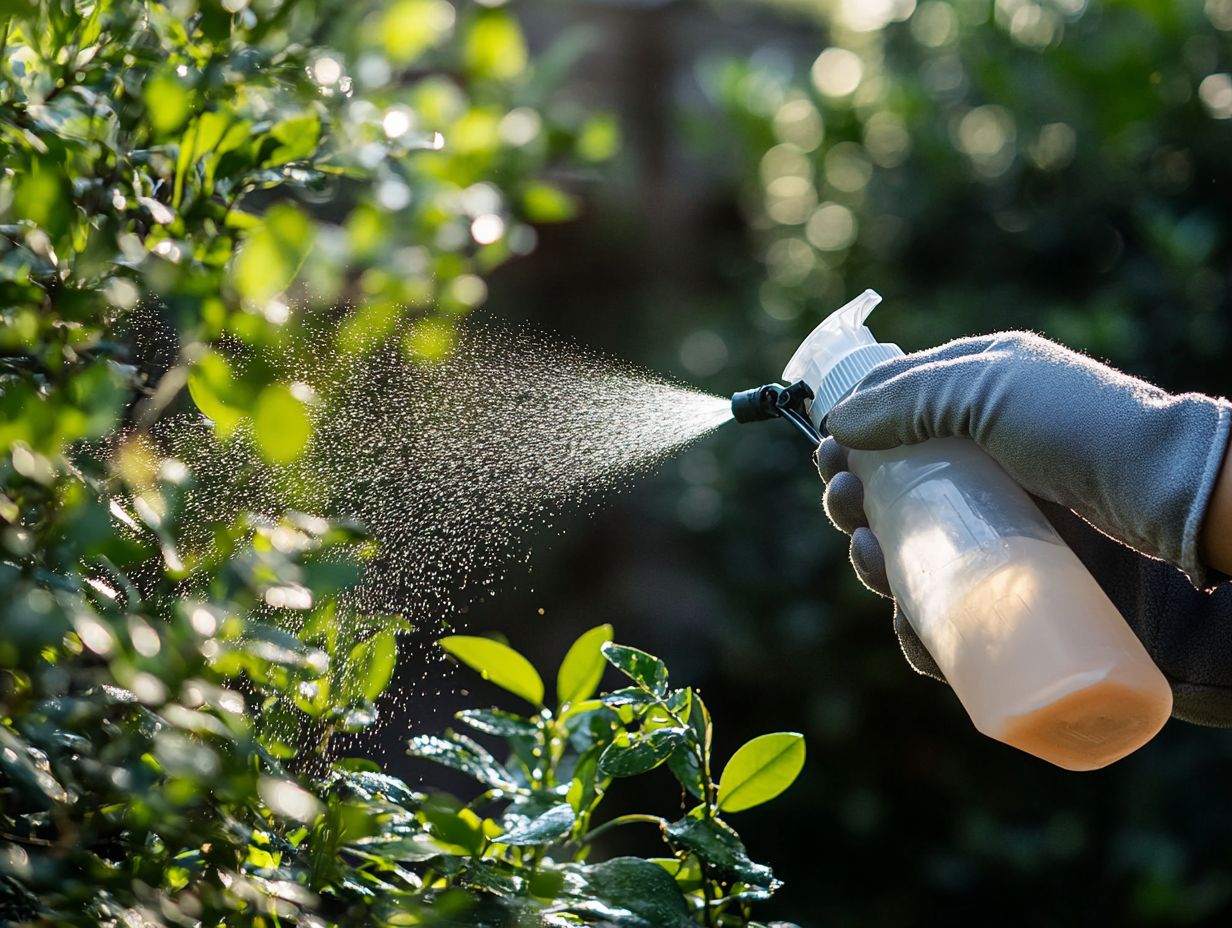
- Use insecticidal soap to effectively control pests without harming plants or the environment.
- Follow proper application techniques and safety precautions to ensure the safe and effective use of insecticidal soap.
- Avoid common mistakes like overuse or misapplication, and consider alternative pest control methods to find the best solution for your specific situation.
Understanding Insecticidal Soap
Insecticidal soap is a specialized solution crafted to tackle a variety of insect pests, particularly soft-bodied nuisances like aphids and mealybugs. It utilizes potassium hydroxide and fatty acids to achieve this.
This eco-friendly tool disrupts the cell membranes of these pests, leading to their dehydration and ultimately, their end. The formulation typically features a blend of natural fatty acids as the active ingredient, complemented by potassium salts, which enhance the soap s penetration and efficacy against the targeted insects.
Not only does it effectively combat common garden invaders, but it also targets whiteflies, spider mites, and thrips, making it a versatile choice for both home gardeners and commercial growers alike. Its non-toxic nature ensures safety around beneficial insects when applied correctly, allowing you to maintain a balanced approach to pest control.
What s particularly appealing is its safety for beneficial insects such as lady beetles and lacewings. This non-toxic alternative helps in maintaining garden health while effectively managing pest populations without resorting to harsh chemicals.
Esteemed by organic gardeners and endorsed by experts from institutions like Clemson University and Safer Brand, insecticidal soap is celebrated for its ability to uphold garden health.
What is Insecticidal Soap?
Insecticidal soap is a specialized solution crafted to tackle a variety of insect pests, particularly those soft-bodied nuisances like aphids and mealybugs, utilizing potassium hydroxide and fatty acids.
This eco-friendly tool disrupts the cell membranes of these pests, leading to their dehydration and ultimately, their end. The formulation typically features a blend of natural fatty acids as the active ingredient, complemented by potassium salts, which enhance the soap s penetration and efficacy against the targeted insects.
Not only does it effectively combat common garden invaders, but it also takes aim at whiteflies, spider mites, and thrips, making it a versatile choice for both home gardeners and commercial growers alike. Its non-toxic nature ensures safety around beneficial insects when applied correctly, allowing you to maintain a balanced approach to pest control.
Benefits of Using Insecticidal Soap
Insecticidal soap offers many benefits for pest management. This effective insecticide reduces plant damage and ensures a safe application for both harmful and beneficial insects.
Temperature and humidity can affect how well the soap works. For instance, applying insecticidal soap during extreme weather conditions can jeopardize both performance and safety.
Effective Pest Control
Insecticidal soap stands out as a highly effective pest control solution, adept at targeting a wide array of insect pests throughout their life cycles, from eggs to larvae to adults.
This remarkable formulation works by suffocating soft-bodied insects, making it particularly effective against common garden nuisances like aphids, whiteflies, and spider mites. When you apply it as a foliar spray, the soap envelops these pests, disrupting their ability to breathe and reproduce.
For instance, when you implement pest management strategies to tackle an aphid outbreak on young plants, the soap not only targets the adult insects but also helps eliminate emerging larvae.
It also plays a crucial role in maintaining a vibrant garden ecosystem. When used correctly and selectively, it has minimal impact on beneficial insects, allowing for harmonious coexistence while managing pest populations efficiently.
Safe for Plants and Environment

Insecticidal soap is celebrated for its safe application across a diverse range of plants. It presents minimal risk of phytotoxicity the risk of damage to plants when used correctly, thus maintaining the overall health of your garden.
As a gardener, it s essential to follow the application guidelines meticulously to ensure your foliage remains unharmed. Different plant types whether succulents, flowering shrubs, or leafy greens exhibit varying sensitivities to these treatments.
Environmental factors such as temperature and humidity significantly influence effectiveness. For instance, applying insecticidal soap during extreme heat or cold can jeopardize both performance and safety.
Being mindful of timing and adhering to recommended practices is crucial for achieving optimal results while preserving the vitality of your plants.
How to Properly Use Insecticidal Soap
Proper usage of insecticidal soap is essential to maximize its effectiveness. By following the application instructions meticulously, you ensure that the soap solution is adequately diluted, effectively targeting insect pests while safeguarding your plants from potential harm.
Application Techniques
To effectively apply insecticidal soap, you should focus on thoroughly coating the leaf surfaces of your plants. Make sure the soap solution directly contacts the insect pests to maximize your control options.
In terms of timing, your application can significantly influence effectiveness. For the best results, aim to spray during the early morning or late afternoon when temperatures are cooler this minimizes the risk of leaf burn.
A fine mist from a spray bottle or garden sprayer will help you achieve even coverage, reaching pests that may be lurking on both the upper and lower leaf surfaces.
Keep a close eye on pest populations and be prepared to repeat applications every 7-10 days, especially during peak activity periods. By sticking to this routine, you’ll manage various pest life stages and keep them under control.
Safety Precautions
When using insecticidal soap, it s essential to observe safety precautions. This not only protects beneficial insects but also safeguards the environment, while minimizing the risk of plant damage. Timing is everything. Applying insecticidal soap when beneficial insects are less active ensures minimal insect exposure to the treatment.
Before you apply the solution, it s wise to test it on a small, inconspicuous area of the plant. This simple step helps confirm that there are no adverse reactions. Steer clear of using the soap during extreme weather conditions, such as scorching heat or heavy rain, as these can diminish its effectiveness and potentially harm your plants or beneficial insects.
Timing is everything. Applying insecticidal soap when beneficial insects are less active, typically in the early morning or late evening, ensures that your natural predators remain unharmed. This approach allows them to continue their vital role in maintaining your garden’s ecological balance.
Common Mistakes to Avoid
Don t let common mistakes ruin your pest control! Using insecticidal soap correctly is key to its success. Overuse or improper application can diminish insect control and even harm your plants.
Overuse and Misapplication

Overusing and misapplying insecticidal soap can seriously undermine its effectiveness as a pest control solution. This could lead to plant damage and harm your plants.
When applied in excess, the soap can disrupt the protective cuticle of leaves, resulting in unwanted injuries like leaf burn or discoloration.
Insect pests may develop resistance to the soap, diminishing its effectiveness over time. To minimize these risks, it s essential to follow the recommended application rates, which typically shouldn t exceed a concentration of 2-3% soap in water.
Space your applications about 7 to 10 days apart to give your plants time to recover and to effectively target new pest generations. By carefully monitoring both your plants and the pests, you can ensure successful outcomes.
Alternatives to Insecticidal Soap
Exploring alternatives to insecticidal soap is crucial for a well-rounded pest control strategy. Consider natural insecticides like neem oil and pyrethrin, each bringing distinct benefits to the table.
By broadening your pest management toolkit, you can effectively address various challenges while maintaining a more eco-friendly approach.
Comparing Different Pest Control Methods
When comparing different pest control methods, it s essential to evaluate the safety and effectiveness of various insecticidal products available in the market or natural insecticides.
Among these options, insecticidal soap, neem oil, and pyrethrin truly shine with their distinct qualities. Insecticidal soap excels against soft-bodied insects like aphids and spider mites and boasts low toxicity to humans and pets, making it a reliable choice for households.
Neem oil comes from the seeds of the neem tree and is used as a natural pesticide. It not only eradicates pests but also disrupts their reproductive cycles, though you might need to apply it multiple times for the best results.
Pyrethrin, sourced from chrysanthemum flowers, acts swiftly but poses risks to beneficial insects and aquatic life, raising valid concerns about its wider environmental implications. By understanding these characteristics, you can make an informed choice tailored to your specific pest challenges.
Frequently Asked Questions
What is insecticidal soap and how does it work?
Insecticidal soap is a natural and non-toxic product made from fatty acids and potassium salts like potassium hydroxide. These fatty acids are natural substances found in plants and animals that help break down insect membranes. It works by disrupting the membranes of soft-bodied insects, causing them to dehydrate and die.
How do I use insecticidal soap safely?
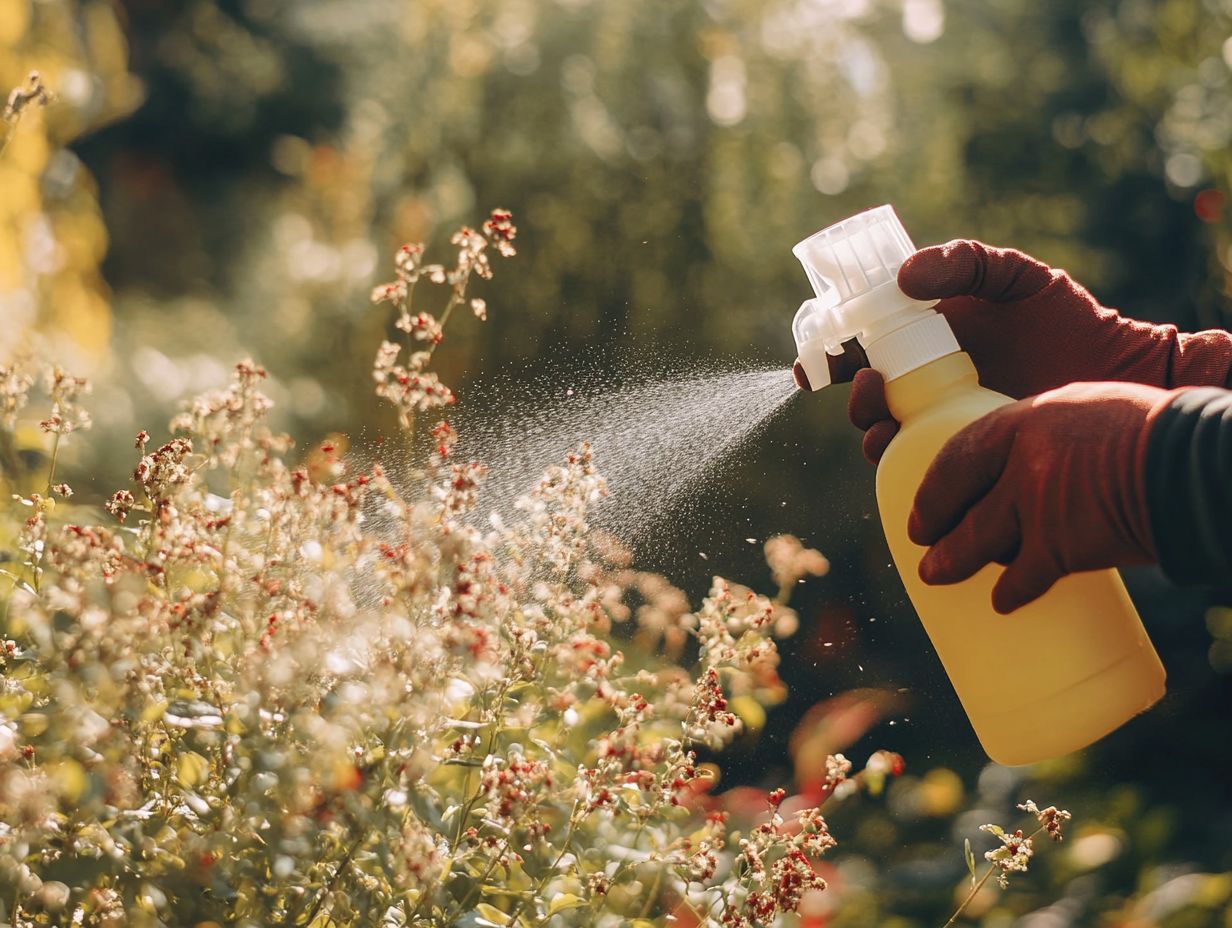
First, read the instructions on the label carefully. Wear protective gloves and eyewear while using the product.
Avoid contact with skin and eyes. Keep children and pets away from treated areas.
Can I use insecticidal soap on all plants?
No, insecticidal soap may harm some plants, especially those with sensitive or hairy leaves. Always test a small area of the plant, particularly its leafy surfaces, before treating the entire plant.
How often should I apply insecticidal soap?
The frequency of application depends on the severity of the insect problem and associated pest pressure.
Reapply every 7-10 days to keep those pesky insects at bay! Act quickly to tackle those pests and protect your plants.
Making Insecticidal Soap at Home
Yes, you can make your own homemade insecticidal soap. Mix one tablespoon of mild liquid soap with one quart of water to create a soap solution that can effectively control insect pests.
However, commercial insecticidal products are often more effective and less damaging to plants, providing effective insecticides for various insect types.
What should I do if I accidentally ingest insecticidal soap?
If ingested, immediately rinse your mouth with water and drink plenty of water. Seek medical attention if any symptoms persist, especially if insect exposure leads to allergic reactions.
Always store insecticidal soap out of reach of children and pets.



